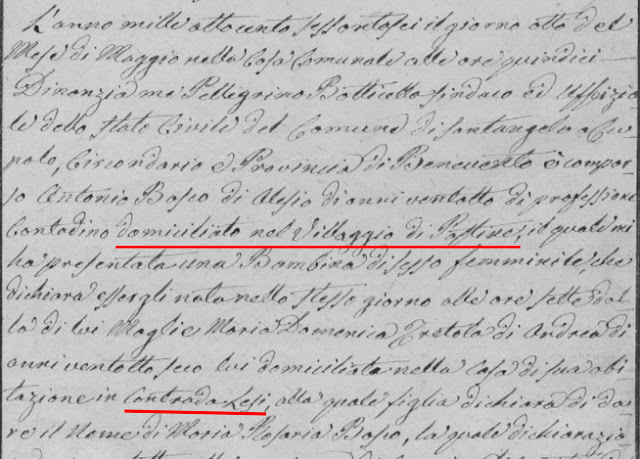I spent this past weekend hunting. For people. For a few of my missing fifth great grandparents.
And I found them!
Because I write this blog twice a week, I've gotten very focused on how I do things. I'm filling in my Grandparent Chart ancestor by ancestor by following my own advice.
Let me show you how I'm methodically adding the names of missing ancestors to my family tree.
Step One: Have Resources Ready to View
 |
| My collection of documents. |
If your ancestors were Italian, their town's vital records might be on the Antenati website. If so, I hope you've used the GetLinks program to download all the records to your computer. (See Collect the Whole Set!)
I have vital records from my Italian ancestral hometowns on my desktop. I'm processing these thousands of images in a couple of ways:
- One-by-one I'm typing their facts into a spreadsheet database.
- I'm choosing someone from my family tree to pursue—going after their birth, marriage and death records.
It's important to have my family tree software open as I go through the images. I can check out any familiar name to see if they're a relative.
Step Two: Crop and Add Facts to Images
- I rename the image file so it's easy to find again.
- I drag the image into Photoshop to crop it and save it with its final name in my folder of vital records.
- I right-click the image and choose Properties, and then the Details tab. Here I can annotate the images and enter the title as I want it to appear in my family tree. For example, "1811 birth record for Maria Vincenza Liguori". In the Comments section, I enter the URL where the image exists online.
Step Three: Add Images and Facts to Tree
 |
| Adding more details to images. |
I like to set the most important image I have for a person as their profile picture. This is helpful when I'm looking at the family view. I can see at a glance that I've already found someone's birth record, for example.
Step Four: Update Index of Images
 |
| Adding newly found documents to my Document Tracker spreadsheet. |
Step Five: Add New Ancestor Names to Grandparent Chart
 |
| My Grandparent Chart keeps track of my ancestor-finding progress. |
Step Six: Add New Last Names to My Surname Chart
 |
| My surname list. |
I may be methodical, but I can work on a whim, too. Sometimes I choose a year and start documenting the vital records in my spreadsheet. If that leads me to a brand new ancestor, I'm thrilled!
Other times I begin with my Grandparent Chart and choose a target. Which missing ancestor do I want to find?
That's how I found one particular set of 5th great grandparents this weekend. I'd discovered a 4th great grandmother named Apollonia Caruso.
I love that name. I can't see or hear the name Apollonia without thinking of "The Godfather, Part II."
But I didn't know her parents' names. She married before 1809—the year the Italian civil record keeping began.
I found her children's birth records, but they don't include her parents' names. So I found her son, my 3rd great grandfather Francesco Saverio Liguori's 1840 marriage records.
Apollonia had died by then. Her death record should have been included. Instead, there was a long letter explaining that she had died, but no one could remember when! The town clerk couldn't find her death record because he didn't know where to look.
I decided to do his job and find her death record.
This story deserves a separate blog post, so let's just say I found her death record, and much more! I'll tell you how I did it next time.



















